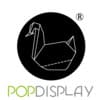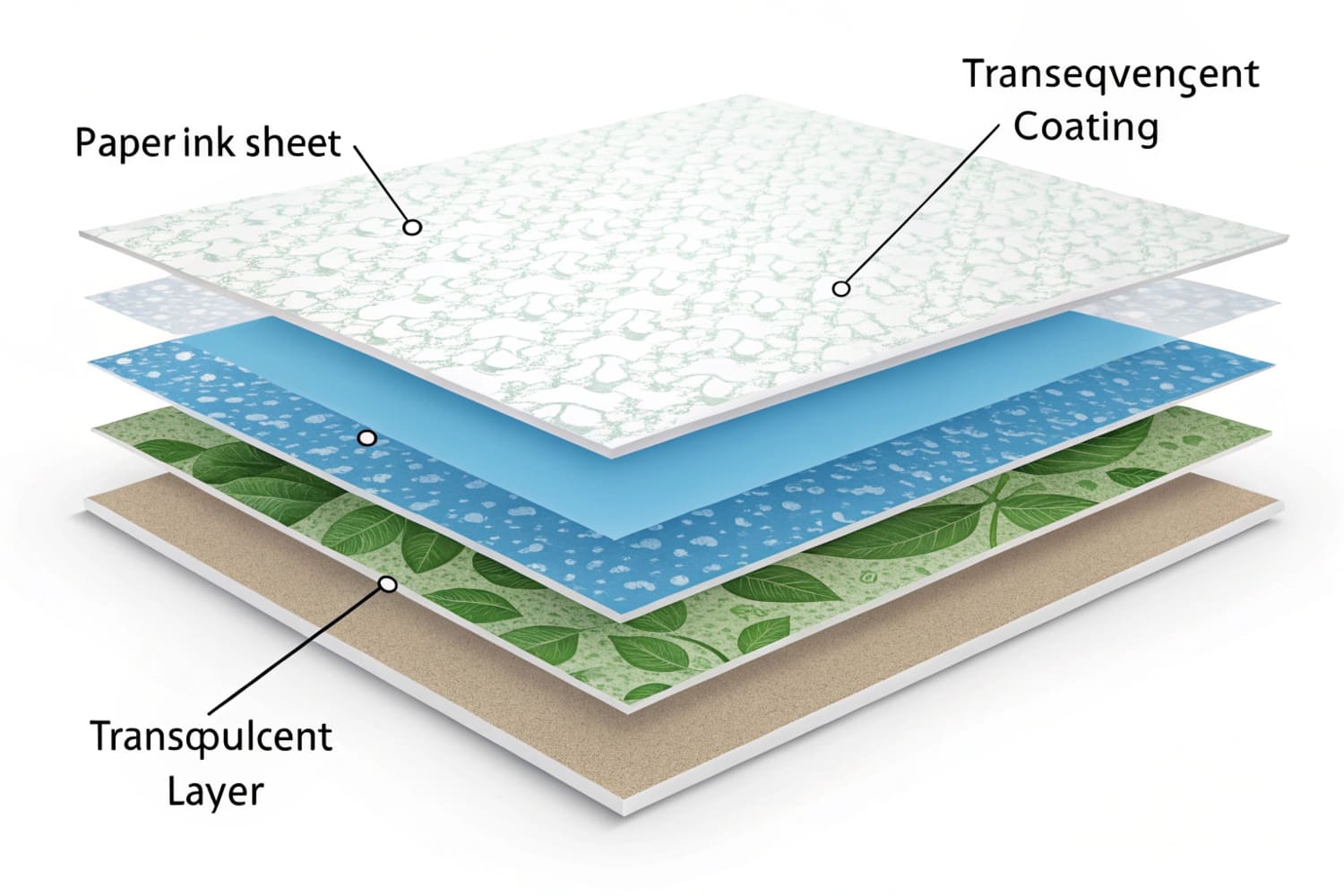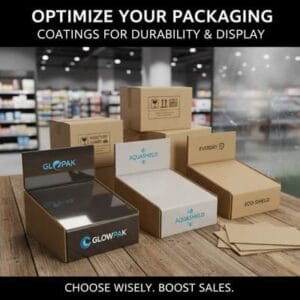Retail displays look great on screens but fail in stores. Colors scuff, inks smear, deadlines slip. I fix that risk with a simple tool that fits tight timelines: aqueous coating.
Aqueous (AQ) coating is a water-based protective layer applied to printed paperboard. It dries fast inline, resists scuff and fingerprints, offers gloss or matte looks, keeps VOCs low, and preserves recyclability for most paper streams.
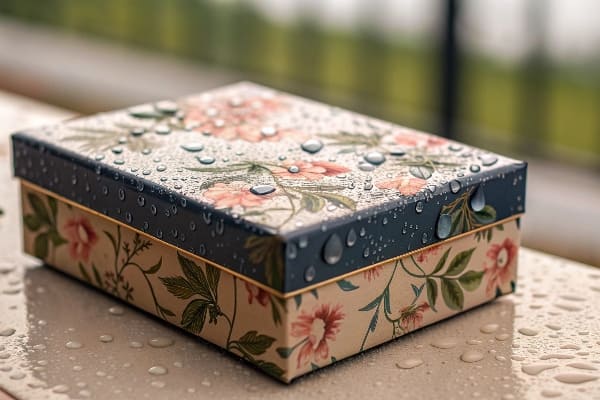
I run a POP display factory in Shenzhen. U.S. buyers want speed. Europe asks for greener specs. APAC grows fast and needs scale. AQ helps me balance all three. Now I will explain what AQ means and how it compares with non-aqueous films, PLA film, and UV coating.
What does aqueous coating mean?
Retail floors are harsh. People touch. Carts bump. Boxes rub. Uncoated prints look tired fast. I use AQ because it adds protection without slowing schedules or blocking recycling.
Aqueous coating means a water-based acrylic or polyurethane dispersion that forms a thin, clear film on paperboard to protect ink, control gloss, reduce rub, speed drying, and meet low-odor, low-VOC requirements.
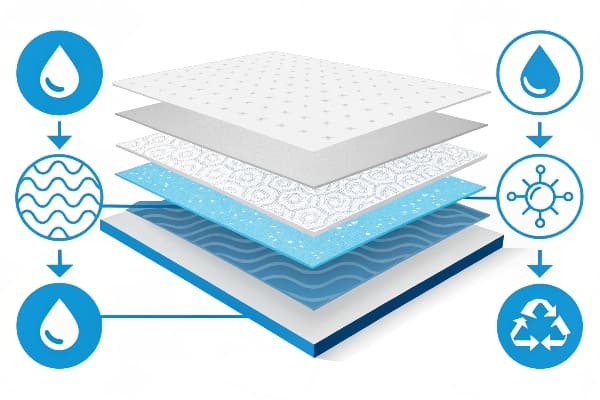
How AQ works
AQ uses water as the carrier. The formula includes acrylic or polyurethane polymers, wax for slip, and additives for clarity and rub resistance1. We apply it inline after printing. We use anilox or coating units on offset or flexo presses. Hot air and IR remove water. The polymers coalesce into a clear film. This process takes minutes, not days. So my team can cut, crease, glue, pack, and ship on tight retail calendars.
Key properties you can plan around
– Fast throughput for promo windows and product launches
– Safer shop air and easier permits due to low VOCs2
– Good rub resistance for shippers, club stores, and floor traffic
– Many finishes: gloss, satin, matte, soft-touch, pearlescent variants
-* Food-contact and toy-safe versions available from suppliers
Typical production specs (for quoting and QC)
| Property | Typical Range / Note |
|---|---|
| Dry time (inline) | 1–5 minutes with IR/hot air |
| Coat weight | 6–12 g/m² (dry) |
| Gloss (60°) | Matte 10–20, Satin 25–45, Gloss 60–75 |
| Rub resistance | Good; add wax for heavy shippers |
| Crack at folds | Low with correct scoring and grain |
| Recyclability | Generally compatible with paper recycling |
| Odor | Very low after cure |
What is the difference between aqueous and non aqueous film coating?
Some buyers ask for “film” because it feels tougher. That can help, but it adds cost and waste. I choose film only when conditions truly demand it.
Aqueous coating is a thin water-based layer on paper, while non-aqueous film coating uses solvent varnishes or laminates plastic film to paperboard; films improve barrier and gloss but add cost, time, and recycling hurdles.
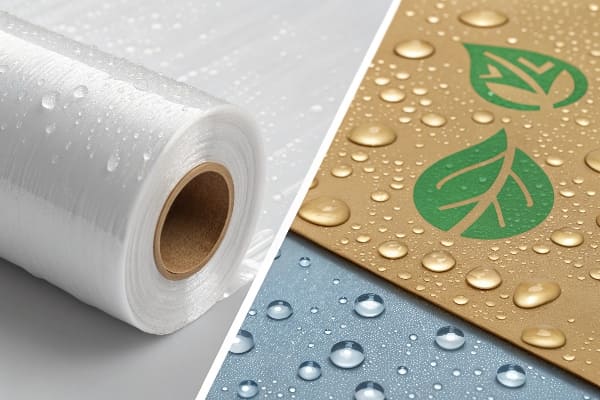
Head-to-head for POP displays
I break “non-aqueous film coating3” into two common paths. One is solvent-based varnish. The other is plastic film lamination like BOPP or PET. Solvent varnish dries by solvent evaporation and oxidation. It can smell stronger, demand more safety controls, and take longer to fully harden. Film lamination bonds a plastic layer to paperboard. It is very glossy and very scuff-resistant. It also resists moisture better. But it needs extra steps, separate machines, and longer lead time. It also makes the sheet harder to recycle because paper mills must separate film from fiber. For big club pallets, wet retail entries, or high-touch interactive displays, film can be worth it. For typical seasonal promotions, AQ delivers speed, cost control, and lower impact.
| Criteria | AQ Coating | Solvent Varnish | Plastic Film Lamination4 |
|---|---|---|---|
| Dry/Cure speed | Very fast inline | Moderate | Extra process |
| VOCs/odor | Very low | Higher | Low, but adhesives add steps |
| Gloss level | Matte–Gloss | Satin–Gloss | Extreme gloss/clarity |
| Scuff resistance | Good | Good | Excellent |
| Moisture resistance | Moderate | Moderate | High |
| Print feel | Natural paper feel | Slightly sealed | Plastic touch |
| Recyclability | Generally friendly | Mixed | Often reduced |
| Cost/lead time | Low/short | Medium/medium | Highest/longest |
What is the difference between PLA and aqueous coating?
Many teams hear “PLA” and think “green.” PLA can help. It is still a plastic film. It behaves like film in production and in recycling streams.
PLA is a bio-based plastic film used in lamination, while AQ is a water-based liquid coating; PLA adds a compostable film layer under strict conditions, but AQ protects print while keeping paper easier to recycle.
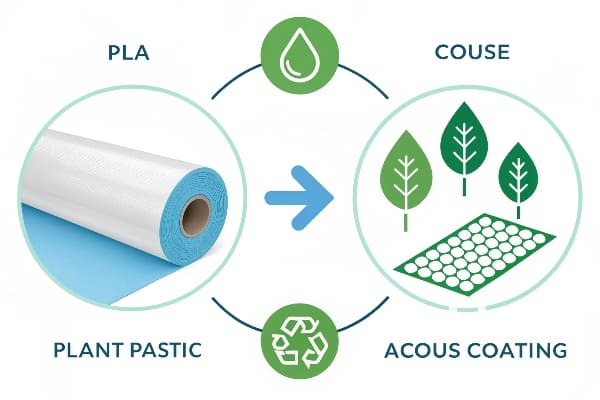
Where each makes sense
PLA film5 comes from renewable feedstocks. It looks clear and prints well. It runs like other films on laminators. It can claim bio-based content. It may be industrially compostable, but only in facilities that accept it. Most curbside systems do not. Paper mills also do not like film-laminated sheets, even when the film is PLA. So you should check your end-of-life path before you spec PLA. AQ stays on the paper. It usually passes through paper recycling with fewer issues. It avoids plastic feel and still protects ink. For moisture-heavy use or repeated handling, PLA film can win on durability. For speed, unit cost, and broad sustainability fit, AQ often wins in retail displays.
| Criteria | AQ Coating6 | PLA Film Lamination |
|---|---|---|
| Material type | Water-based coating | Bio-based plastic film |
| Finish options | Matte to gloss | High clarity, gloss |
| Durability | Good | Very good |
| Compostability | N/A | Industrial only, limited access |
| Recyclability with paper | Generally good | Often poor due to film |
| Lead time | Short, inline | Longer, offline |
| Cost | Lower | Higher |
| Feel | Paper-like | Plastic touch |
What is the difference between aqueous and UV coating?
Launch teams love the mirror gloss of UV. It is tough and instant. It also needs lamps, careful ink choices, and attention to cracking at folds.
UV coating cures with ultraviolet light into a hard, high-gloss film with excellent rub and chemical resistance; AQ dries by heat and air, gives versatile finishes, costs less, and is friendlier to paper recycling.
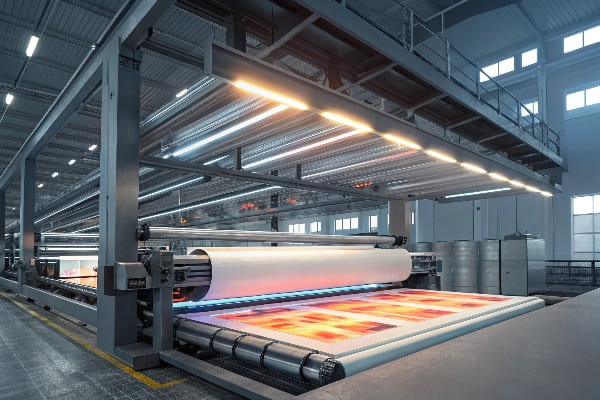
Production reality and buyer trade-offs
UV coating7 uses acrylate oligomers, monomers, and photoinitiators. It cures in seconds under UV lamps. The surface becomes very glossy and very hard. It resists alcohol wipes and many cleaners on store floors. It can also crack on tight scores if the sheet is too dry or the fold is sharp. It may show “edge chipping” on die-cuts if the film is thick. Dark coverage can reveal streaks if the roller setup is not perfect. AQ is more forgiving on folds and scores. It works well for large runs and for mixed-finish portfolios, like matte bodies with spot-gloss accents. UV needs more energy and lamp maintenance. AQ needs heat and air. I choose UV for premium hero bays, fragrance-like beauty displays, or long-life counter units. I choose AQ for fast turns, national promotions, and pallet displays where speed and recycling matter most.
| Criteria | AQ Coating8 | UV Coating |
|---|---|---|
| Cure | Heat/air evaporation | UV photopolymerization |
| Gloss | Matte–Gloss | Very high gloss |
| Rub/Chemical resistance | Good | Excellent |
| Folding performance | Very good | Can crack if thick |
| Energy/Equipment | Lower; IR/hot air | Higher; UV lamps |
| Print compatibility | Broad | Needs UV-friendly inks |
| Recyclability | Generally friendly | Mixed; thicker films can hinder |
| Cost/lead time | Lower/shorter | Higher/longer |
Conclusion
Choose AQ for speed, cost, and recyclability. Choose film, PLA, or UV only when the environment, touch level, or brand look demands more barrier or extreme gloss.
Understanding rub resistance is crucial for ensuring packaging withstands handling and transport, making this resource valuable for production planning. ↩
Exploring this link will provide insights into how low VOCs improve air quality and safety in printing environments. ↩
Understanding non-aqueous film coating can enhance your knowledge of modern coating technologies and their benefits. ↩
Exploring the benefits of Plastic Film Lamination can help you make informed decisions for packaging solutions. ↩
Explore the advantages of PLA film, including its sustainability and performance in various applications. ↩
Learn about AQ coating’s benefits and how it stands out against other options in the packaging industry. ↩
Explore the advantages of UV coating, including its durability and glossy finish, to enhance your printing projects. ↩
Learn about AQ Coating’s versatility and benefits for various printing needs, especially for fast production and recycling. ↩
